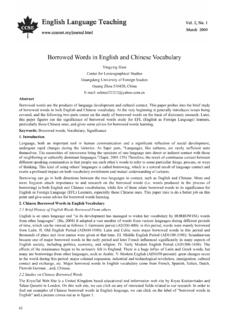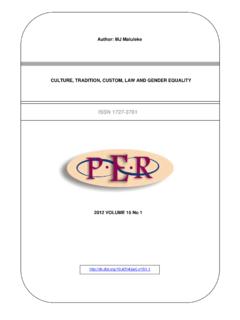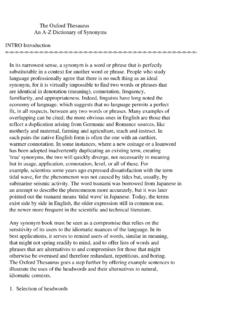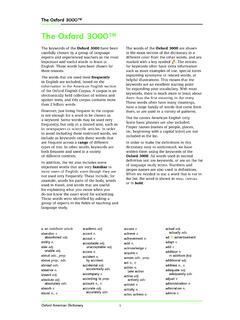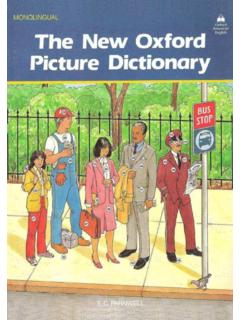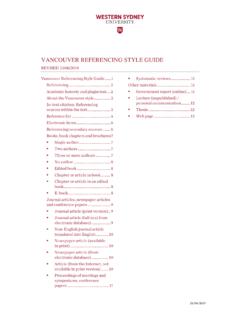Transcription of CHAPTER Defining Culture 1 and Identities
1 CHAPTER1 FOCUS QUESTIONS In general, how does Culture provide for humans? What are the meanings of the terms Culture , subculture, ethnicity, co- Culture , subculture, subgroup, and race? What are some of the major issues in today s cultural contact zones? Defining Culture and IdentitiesRegulators of Human Life And IdentityCultureNineteenth-Century DefinitionToday s DefinitionCultures Within CulturesSubcultureEconomic or Social ClassEthnicityCo-CultureCase Study: American IndiansSubgroupDefinitionDeviant LabelTemporality Wannabe BehaviorRace and Skin ColorThe Concept of RaceIdentity and RaceThe Contact ZoneToday s Contact Zone ChallengesEthnic and Religious ConflictRole of WomenTechnologyMigrationEnvironmental SustainabilitySummaryDiscussion QuestionsKey TermsNoteReadingsStudent Study SiteCHAPTER 1 Defining Culture and Identities5 Today about 7 billion people live on Earth, and no two of them alike.
2 People can be small and large and in many colors. We wear different clothes and have different ideas of beauty. Many of us believe in one God,1 others believe in many, and still others believe in none. Some people are rich and many are desperately poor. Have you ever considered why there s not one human Culture rather than many cultures? Biologists Rebecca Cann, Mark Stoneking, and Allan C. Wilson (1987) studied genetic material from women around the world and contend that all humans alive today share genetic material from a woman who lived some 200,000 years ago in sub-Saharan Africa. Their African Eve conclusion may be supported by linguistic observations. Cavalli-Sforza, Piazza, Menozzi, and Mountain (1988) have shown that considerable similarity exists between Cann s tree of genetic relationships and the tree of language groups, which hypothesizes that all the world s languages can be traced to that are the most different from other languages today can be found in Africa.
3 This may suggest that they are older. Africa s Khoisan languages, such as that of the !Kung San, use a clicking sound, which is denoted in writing with an exclamation point. Such evidence, along with genetic evidence, suggests that all of us alive today share ancestry from one group in Africa. How then did diverse cultures develop?Climate changes or some other pressure led to migrations out of Africa. The first may have been along the coastline of southern Asia through southern India into Australia. The second wave may have traveled to the Middle East, and from there, one branch went to India and a second to China. Those who left the Middle East for Europe may have actually traveled first through Central Asia and then throughout the world to other parts of Asia, Russia, the Americas, and Europe (Wells, 2002).
4 Centuries of geographical separation were concurrent with the development of diverse ways of interpreting the world and the environment and relating to other peoples. Neurosci-entist Antonio Damasio (2010) contends that our world, our environment, is so complex and so varied on the planet that social networks and cultures developed to regulate life so that we could survive. For much of the latter part of the 20th century, the dominant worldview was us versus them. Failures of political leadership led to two world wars and many regional wars. Today s challenges in the contact zone where cultures interact are identified as ethnic and religious conflict, the changing role of women, technology, migration, and environmental OF HUMAN LIFE AND IDENTITYAs Damasio suggests, Culture is a regulator of human life and identity.
5 That regulatory func-tion extends to cultures within cultures, which we will study as subcultures, co-cultures, and provide diverse ways of interpreting the environment and the world, as well as relat-ing to other peoples. To recognize that other peoples can see the world differently is one thing. To view their interpretations as less perfect that ours is 1 Culture AS CONTEXT FOR COMMUNICATION6 This can be seen in the evolution of the connotative meaning of the word barbarian from its initial use in the Greek of Herodotus to its meaning in contemporary english (Cole, 1996). To better understand the origins of hostilities between the Greeks and the Persians, Herodotus visited neighboring non-Greek societies to learn their belief systems, arts, and everyday prac-tices.
6 He called these non-Greek societies barbarian, a word in Greek in his time that meant people whose language, religion, ways of life, and customs differed from those of the Greeks. Initially, barbarian meant different from what was , the Greeks began to use the word to mean outlandish, rude, or brutal. When the word was incorporated into Latin, it came to mean uncivilized or uncultured. The oxford english dictionary gives the contemporary definition as a rude, wild, uncivilized person, but acknowl-edges the original meaning was one whose language and customs differ from the speaker s. Nineteenth-Century DefinitionIn the 19th century, the term Culture was commonly used as a synonym for Western civiliza-tion.
7 The British anthropologist Sir Edward B. Tylor (1871) popularized the idea that all societ-ies pass through developmental stages, beginning with savagery, progressing to barbarism, and culminating in Western civilization. It s easy to see that such a definition assumes that Western cultures were considered superior. Both Western cultures, beginning with ancient Greece, and Eastern cultures, most notably imperial China, believed that their own way of life was superior. The study of multiple cultures without imposing the belief that Western Culture was the ultimate goal was slow to s DefinitionCultures are not synonymous with countries. Cultures do not respect political boundaries.
8 Border cities such as Ju rez, El Paso, Tijuana, and San Diego can develop cultures that in some ways are not like Mexico or the United States. For example, major stores in border cities routinely accept Mexican this text, Culture refers to the following: A community or population sufficiently large enough to be self-sustaining; that is, large enough to produce new generations of members without relying on outside people. The totality of that group s thought, experiences, and patterns of behavior and its concepts, values, and assumptions about life that guide behavior and how those evolve with contact with other cultures. Hofstede (1994) classified these elements of Culture into four categories: symbols, rituals, values, and heroes.
9 Symbols refer to verbal and nonverbal language. Rituals are the socially essential collective activities within a Culture . Values are the feelings not open for discussion within a Culture about what is good or bad, beautiful or ugly, normal or abnormal, which are present in a majority of the members of a Culture , or at least in those who occupy pivotal positions. Heroes are the real or imaginary people who serve as behavior models within a Culture . A Culture s heroes are expressed in the Culture s myths, which can be the subject of novels and other forms of literature (Rushing & Frentz, 1978). Janice Hocker Rushing (1983) has argued, for example, that an enduring myth in Culture , as seen in films, is the rugged individualist cowboy of the American 1 Defining Culture and Identities7 The process of social transmission of these thoughts and behaviors from birth in the family and schools over the course of generations.
10 Members who consciously identify themselves with that group. Collier and Thomas (1988) describe this as cultural identity, or the identification with and perceived acceptance into a group that has a shared system of symbols and meanings as well as norms for conduct. What does knowing an individual s cultural identity tell you about that individual? If you assume that the individual is like everyone else in that Culture , you have stereotyped all the many, various people in that Culture into one mold. You know that you are different from others in your Culture . Other cultures are as diverse. The diversity within cultures probably exceeds the differences between cultures. So just knowing one person s cultural identity doesn t provide complete or reliable information about that person.










